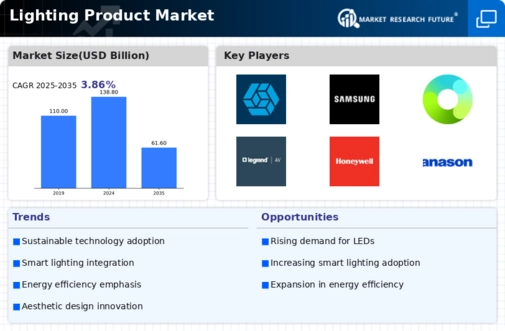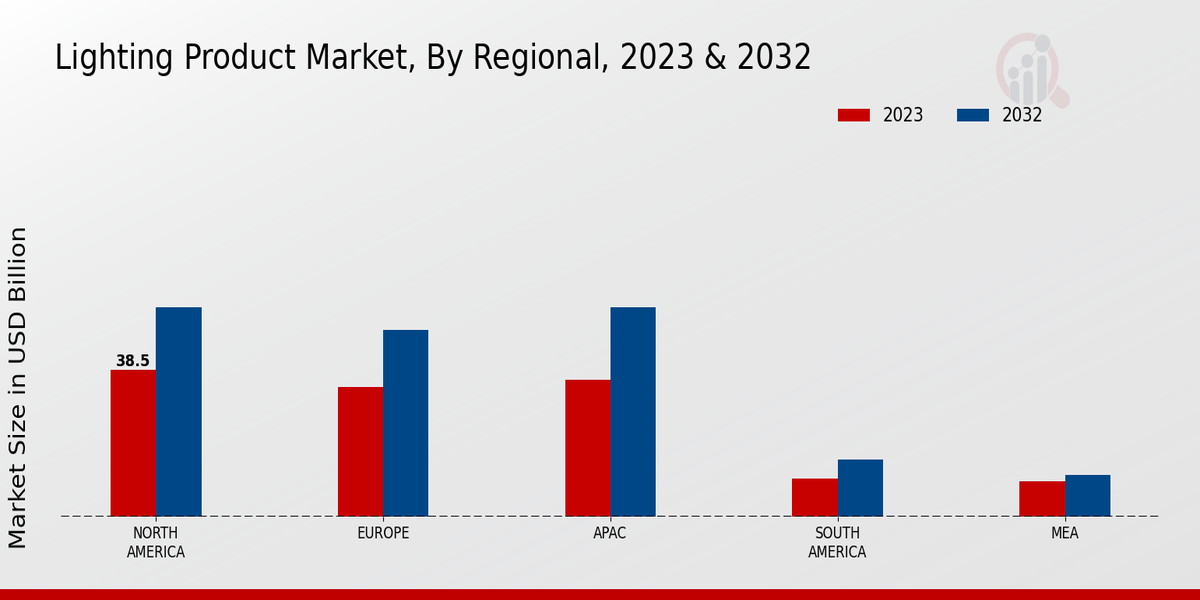Sustainability Trends
Sustainability remains a pivotal driver within the Global Lighting Product Market Industry. There is a marked shift towards eco-friendly lighting solutions, such as LED technology, which offers longer lifespans and lower energy consumption compared to traditional incandescent bulbs. Governments worldwide are implementing regulations to phase out less efficient lighting options, further propelling the adoption of sustainable products. This trend aligns with global efforts to reduce carbon footprints, as LED lighting can consume up to 75 percent less energy. As a result, the market is likely to see a sustained growth trajectory, with a projected value of 138.8 USD Billion by 2024.
Market Growth Projections
The Global Lighting Product Market Industry is poised for notable changes in the coming years. Projections indicate a market value of 138.8 USD Billion in 2024, followed by a decline to 61.6 USD Billion by 2035, reflecting a compound annual growth rate of -7.11% from 2025 to 2035. This anticipated contraction may be attributed to market saturation and the shift towards alternative lighting technologies. As the industry evolves, stakeholders must adapt to changing consumer preferences and technological advancements to remain competitive.
Technological Advancements
The Global Lighting Product Market Industry is experiencing a transformative phase driven by rapid technological advancements. Innovations such as smart lighting systems, which integrate IoT technology, are gaining traction. These systems allow for remote control and automation, enhancing energy efficiency and user convenience. For instance, smart bulbs can be programmed to adjust brightness based on time of day or occupancy, potentially reducing energy consumption significantly. As consumers increasingly seek energy-efficient solutions, the market is projected to reach 138.8 USD Billion in 2024, highlighting the growing demand for technologically advanced lighting solutions.
Regulatory Support and Incentives
Regulatory frameworks and government incentives play a crucial role in shaping the Global Lighting Product Market Industry. Many governments are implementing policies that promote energy-efficient lighting solutions, such as tax rebates and subsidies for LED installations. These initiatives not only encourage consumers to transition to more efficient products but also stimulate market growth. For instance, various countries have set ambitious targets for reducing energy consumption in residential and commercial sectors, which is likely to drive the adoption of advanced lighting technologies. As a result, the market is projected to reach 138.8 USD Billion in 2024, reflecting the positive impact of regulatory support.
Consumer Awareness and Preferences
Consumer awareness regarding energy efficiency and environmental impact is reshaping the Global Lighting Product Market Industry. As individuals become more informed about the benefits of energy-efficient lighting, such as reduced electricity bills and lower environmental impact, demand for products like LEDs is surging. This shift in consumer preferences is evident in retail sectors, where energy-efficient lighting options are increasingly favored. The market's growth is anticipated to continue, with a projected decline in traditional lighting products, leading to an overall market value of 138.8 USD Billion by 2024. This evolution underscores the importance of aligning product offerings with consumer values.
Urbanization and Infrastructure Development
Urbanization is a significant factor influencing the Global Lighting Product Market Industry. As populations migrate towards urban areas, the demand for efficient and effective lighting solutions in public spaces, residential areas, and commercial buildings increases. Infrastructure development projects often prioritize modern lighting systems that enhance safety and aesthetics. For example, cities are investing in smart street lighting that adjusts based on traffic patterns, thereby optimizing energy use. This trend is expected to contribute to the market's growth, with projections indicating a value of 138.8 USD Billion in 2024, reflecting the increasing need for advanced lighting solutions in urban settings.























